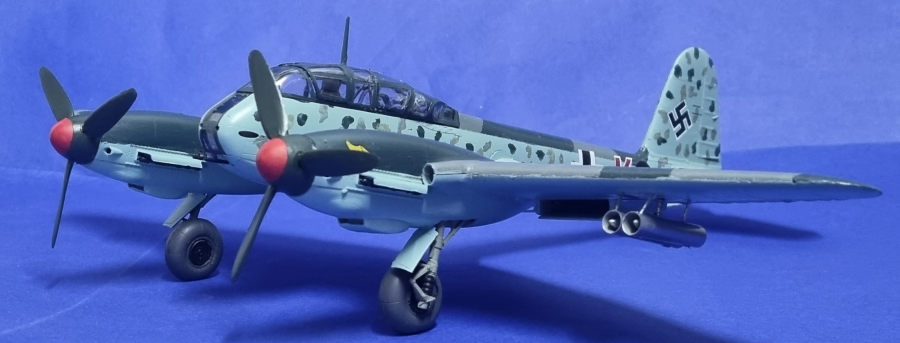
ProModeler 1/48 Me-410B-1
| KIT #: | 5936 |
| PRICE: | 69$ |
| DECALS: | Three options |
| REVIEWER: | Francisco Santoro |
| NOTES: | Decals off register |

| HISTORY |
Kit instructions: “The Messerschmitt Me 410 was base don the design of the previous Me 210 twin engine, heavy fighter. Nicknamed “Hornisse” (Hornet), the Me 410 had wing sltas and a lengthened fuselage. Two 1750 horsepower Daimler Benz 603A engines replaced the 1350hp DB601F powerplants found in the Me 210. These more powerful engines required redesigned nacelles, which were longer than on those of the Me 210. Both Me 210 and Me 410 carried a crew of two who were sitted in tandem beneath a single framed canopy.
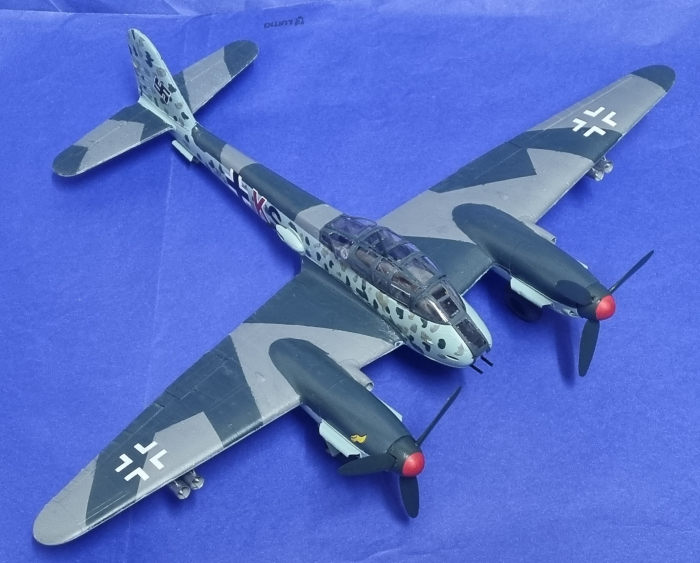 Six
Me 210As were modified to Me 410 standards, and these were joined in
flight testing by the first true Me 410V-1 prototype in late 1942.
During 1943, 291 Me 410s were built, and this was followed b yan
additional 722 in 1944. The Danau Flugzeugabu in Hungary also built 34
Me 410s in 1943 and 74 in 1944, before the plant was destroyed by Allied
bombing attacks.
Six
Me 210As were modified to Me 410 standards, and these were joined in
flight testing by the first true Me 410V-1 prototype in late 1942.
During 1943, 291 Me 410s were built, and this was followed b yan
additional 722 in 1944. The Danau Flugzeugabu in Hungary also built 34
Me 410s in 1943 and 74 in 1944, before the plant was destroyed by Allied
bombing attacks.
The first production version of the Hornisse was the Me 410A-1 light bomber. This was followed by several variants and sub-variants modified for the Zerstörer (Destroyer), bomber destroyer and photographic reconnaissance role.
The first of the B series was the Me 410B-1 which had forward firing 7,9mm MG17 machineguns in place of the 13mm MG131s found in the Me 410ª-1. This was followed by the Me 410B-2 variant. Some Me 410B-1s and B-2s were modified to the U1, U2, U3, U4, R2, R3 and R4 sub-variants. These designations specified different weapons combinations that couid be changed by field modifications. Other Me 410Bs were modified to perform anti-shipping and reconnaissance missions.
An unusual feature of most Me 210s and Me 410s were the two rearward firing 13mm MG131 machineguns which were mounted in movable barbettes on the fuselage sides. This remote controlled armament system was designed to provide rear defence from attacking fighters. In practice, it proved to be unreliable and ineffective.”
| THE KIT |
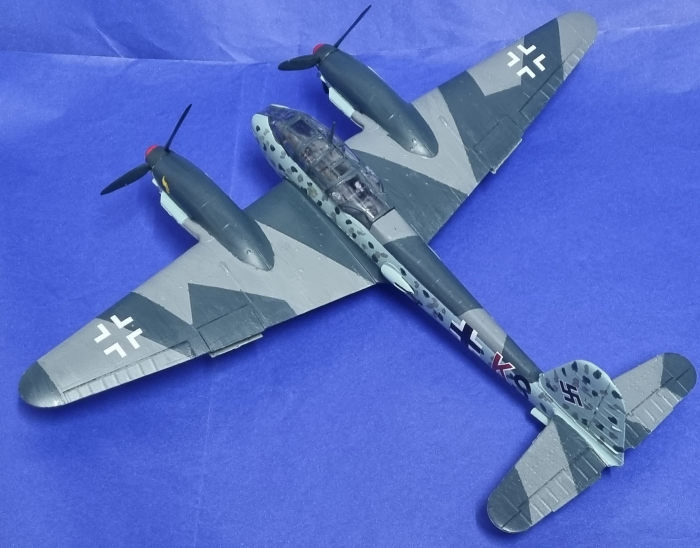 The
Promodeler Me 410B was tooled in 1997. It was subsequently reboxed by Revell
Germany, Hasegawa and more recently, by Promodeler again. The original
tooling comes inside a top opening box with the sprues devided in three
bags, two for the grey tres and a single one for the clear parts. Pieces are
neatly molded with recessed and raised panel lines where they´re required,
with flash on some parts.
The
Promodeler Me 410B was tooled in 1997. It was subsequently reboxed by Revell
Germany, Hasegawa and more recently, by Promodeler again. The original
tooling comes inside a top opening box with the sprues devided in three
bags, two for the grey tres and a single one for the clear parts. Pieces are
neatly molded with recessed and raised panel lines where they´re required,
with flash on some parts.
Three decal options are provided in the kit: Option 1, Me 410B-2/R2 “M8+Black 1” of II/ZG76 based at Königsberg in Germany, November 1944. Option 2 is Me 410B-1/U2/R4 “Chevron and Bar” with an extra gun pod under the fuselage, of II/ZG26, flown by Eduard Tratt (a zerstörer ace with 38 kills and Gruppen Kommandeur of this unit) and based at Königsberg, Germany, 1944. Option 3 (the once I chose) is Me 410B-1/U2 “3U+KS,” which had the underwing Wgr 21 mortars, of 8/ZG26 based at Königsberg-Neumark airfield between 1943 and 1944. Colours are the same for the three aircraft, RLM 74/75 above a 76 fuselage with varying mottle density.
| CONSTRUCTION |
Construction began with the assembly of the propellers, which were painted RLM 70 Black Green (Revell 40 Black Green) for the Blades and nosecones with red front areas.
The wings were next. I opened
the holes for the underwing mortars and then glued the wings together. These
come as a left and right assem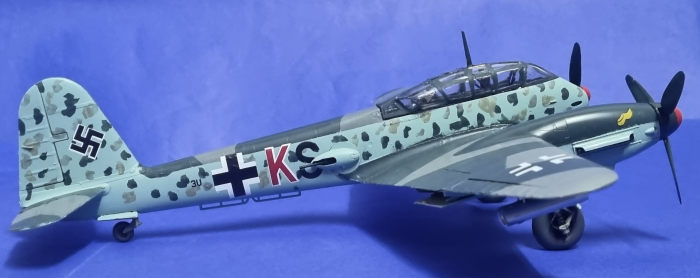 bly,
no single piece lower wing as we’re accustomed. This means you´ll have to
hold the wings while the glue hardens, or else they´ll fall orleave ugly
steps at the wingroots.
bly,
no single piece lower wing as we’re accustomed. This means you´ll have to
hold the wings while the glue hardens, or else they´ll fall orleave ugly
steps at the wingroots.
I left the wings aside and painted all the cockpit parts RLM 66 (Revell 78 Tank Grey) with black details. The throttle levers were picked with yellow and red handles. The cockpit was then put together and glued to one side of the fuselage. I then glued the other fuselage half and let everything set. The nose machinegun pack was glued under the cockpit opening, which gave the fuselage enough separation for the nose transparency.
I then painted the landing gear struts RLM 02 (Revell 45 Olive Green), wheels, gear doors and clear parts in RLM 74 (Revell 69 Granite Grey).
The engine nacelles come in four halves. Before closing them you have to add the exhausts and their shields.
Once the fuselage had been put together, I grabbed my Vallejo putty and filled all the seams.
| COLORS & MARKINGS |
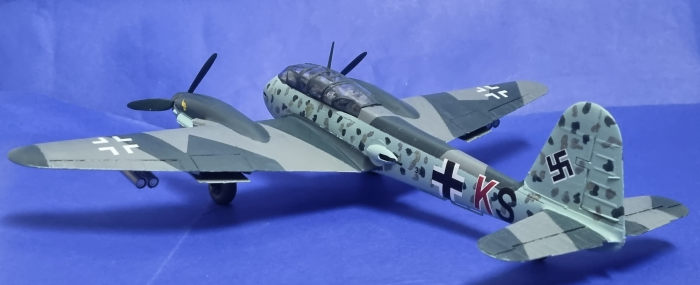 The
model was painted in RLM 74 (Revell Aqua 69 Granite Grey), RLM 75 (Mouse
Grey) and RLM 76 (Revell 49 Light Blue). Mottling was freehanded with a mix
of RLM 74/75/02. I then glossed the model and added the decals, which were
impervious to Microsol and out of register. Once the decals had cured, I
matt coated the plane.
The
model was painted in RLM 74 (Revell Aqua 69 Granite Grey), RLM 75 (Mouse
Grey) and RLM 76 (Revell 49 Light Blue). Mottling was freehanded with a mix
of RLM 74/75/02. I then glossed the model and added the decals, which were
impervious to Microsol and out of register. Once the decals had cured, I
matt coated the plane.
The landing gear struts, gear doors, wheels, props, underwing mortars, rear defensive machineguns and clear parts were glued into their respective places.
| CONCLUSIONS |
Although not able to replace the Bf 110 in the heavy fighter role, the 410 deserves its place in any modeller’s display shelf as the ultimate development of the 110. The kit as of now is out of production, but if you fin done, buy it. Aside from the thick decals, everthing else goes together easily.
| REFERENCES |
Francisco Santoro
29 August 2023 Copyright ModelingMadness.com. All rights reserved. No
reproduction in part or in whole without express permission from the editor.
If you would like your product reviewed fairly and fairly quickly, please contact the editor or see other details in the Note to Contributors.